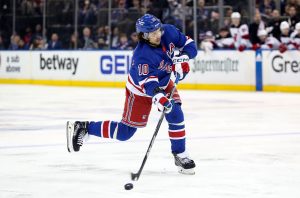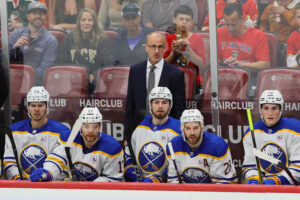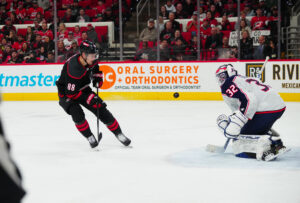One could be forgiven, had they seen the San Jose Sharks games a couple of weeks ago against the Minnesota Wild and Los Angeles Kings, for thinking, “OK, this is what general manager Doug Wilson had in mind.”
Wilson’s 2021 Sharks were supposed to get offence from defence, with studs like Brent Burns and Erik Karlsson providing this. Goalie Martin Jones was supposed to return to form after the long layoff and provide competitive netminding. Players including Tomas Hertl, Logan Couture, Timo Meier and Evander Kane were supposed to provide the team with an unmatched power forward group. The sort who drag opponents behind the net and create scoring chance after scoring chance, while drawing penalties aplenty.
Against the Wild, one of the league’s hottest teams, it worked. The Sharks won twice (once in a shootout) and simply put, they were the better team. Then it happened again against the Kings.
But this isn’t what has happened for most of this season. Nor did it happen last season. Nor did the brief streak continue. The Sharks followed up their four-game win streak by dropping five of the next six, including three to the last place Anaheim Ducks.
Doug Wilson In Three Parts
Wilson undertook an unconventional approach to building the current Sharks and for a variety of reasons, it hasn’t worked. Even if, at times, one can see the blueprint and why it appeared it might work well.
I’ll offer up this. For the most part, I think Wilson has done a remarkable job in his Sharks tenure.
Even his current unconventional approach has merit. Few teams and few systems are built to defend what Wilson had in mind. The league zigged, Wilson zagged. Championships are often won by the team which approaches the game differently from everyone else. The strategy was sound. The execution, not so.
We begin our three-part examination of the Wilson era in San Jose by looking at his journey up to the team’s major inflection point.
Doug Wilson and His Sharks Ride
Wilson has a long and storied history with the Sharks organization.
He joined the Sharks for their inaugural season in 1991 as a player and served as the team’s first captain. Following two years of historically bad team performance, Wilson ended his Hall of Fame playing career.
A decade later, after a disappointing 2002-03 campaign, the team again turned to Wilson, this time asking him to be the top hockey executive. Now 18 years following his hiring, Wilson is among the longest-tenured executives in pro sports.
He’s also at one of the more interesting junctures in his career. Wilson’s tenure as the Sharks top hockey person has been enormously successful, save for missing a Stanley Cup. Indeed, had the Sharks pulled off a Stanley Cup win, it is possible Wilson would be a Hall of Fame member as an executive. But last season’s meltdown and this season’s mediocrity have given reason to question Wilson’s future with the Sharks.
Wilson and His Executive History
During most of his Sharks tenure as an executive, Wilson put together highly competitive teams. The Sharks went to the playoffs 10 consecutive seasons to start Wilson’s tenure, and 14 out of 15.
Under Wilson, the team topped 100 points nine times, three other seasons they finished with 98 or 99. The team won the Presidents’ Trophy for the 2008-09 season.
His signature move, the big trade, brought in tremendous talent. At least four players acquired by trade and who spent prime years with the Sharks have a legit shot at the Hall of Fame when their time comes.
Wilson managed to do the very difficult — turn out strong teams year after year, without the benefit of high draft picks. He helped build a culture that allowed him to retain top talent at reasonable prices – a challenge exacerbated by tax and cost of living disadvantages of the area.
Culture is an area Wilson merits enormous credit. He understood he needed to make San Jose a desirable location for NHL players. San Jose has plenty going for it, but the money simply does not go as far in the Bay Area as in most places. He needed the right culture to sign and retain players.
In a recent interview, former Sharks forward T. J. Galiardi gave an example of Wilson’s willingness to work with a player. Wilson told Galiardi he’d be traded, but gave him his choice of destination, something Galiardi appreciates to this day. This sort of thing might seem small, but the cumulative effect proved essential. Players such as Patrick Marleau and Joe Thornton typically signed deals around three seasons in length. And re-signed several times each. This only happens in an environment of trust.
It’s tempting to say the Sharks’ positive reputation aided Doug Wilson. But it’d be more accurate to say Wilson was integral to developing the Sharks’ positive reputation. Wilson’s understanding of ‘soft skills’ has played an underrated but important role in his success with the franchise.
Doug Wilson, Drafts and Free Agents
Wilson has had mixed success with his drafts and lower-end trades and signings. He’s handcuffed himself by trading away numerous high picks. For lower-end players, some deals worked, but many resulted in players who simply didn’t fit well enough. From Raffi Torres (trade) to Ben Eager (trade) to Adam Burish (free agent), Wilson couldn’t seem to find the right balance between edgy players and those able to make a genuine difference.
Wilson largely spurned prominent free agents, consistently avoiding the top players and only rarely signing middle-class NHL free agents. Trades tend to get talent at lower salaries and more modest term; the combination fit Wilson’s approach. Get the player, have them develop an affinity for San Jose, then retain them at a reasonable price and term.
Wilson didn’t completely spurn free agency, but he did take roads less taken. He signed plenty of European free agents (Scandinavia a specialty) attempting to fill middle-of-the-line-up roles. Alas, most who succeeded wound up filling lower-tier roles.
Wilson has hired quality coaches, albeit ones who never seemed able to raise the team up sufficiently at playoff time. And his inability to find top-quality goalies has also proven an issue. More specifically, he hasn’t found goalies who are top quality in the playoffs, with one ironic exception.
Wilson’s Best Sharks Teams
Often times the Sharks made the playoffs, they had a chance to go far – a legit contender. But there were some Sharks teams simply better than others.
To win a Stanley Cup, teams must be good and lucky. Avoid the hot goalie, avoid key injuries and get a few fortunate bounces. A handful of times, the team was good enough, but some other element went wrong.
In 2009, the Sharks poured on 230 shots on goal against the Anaheim Ducks in six games, but tallied only 10 goals, falling to Jonas Hiller and his .957 save percentage.
In 2010, the Sharks skated relatively evenly in the Western Conference Final against the eventual champion Chicago Blackhawks. Once again, a hot goalie took them out. Antti Niemi posted a .949 save percentage in the series, with every game but one decided by a single goal (excluding an empty netter). The series before, Niemi posted a .898 save percentage, the series after, a .882 save percentage (for which he hoisted the Cup). Two series of modest netminding. But sandwiched in between, in the series against the Sharks, he was brilliant.
In 2011, the Sharks fell to the Vancouver Canucks in the Western Conference Final. In one game, Vancouver managed only 13 shots but scored four times. The Sharks took four penalties in three minutes and the Canucks took full advantage, tallying three 5-on-3 scores in those minutes. The Sharks’ 57 minutes of being the vastly better team didn’t matter that game. Vancouver ended the series on a bizarre and uniquely painful overtime goal. Somehow, the Sharks managed to lose a series in five games, even though they were the better and often dominant team.
Embarrassment
The 2014 reverse sweep against the Los Angeles Kings (who’d win the Stanley Cup that season) was really the story of a terrific Sharks team playing with too many injuries. Dan Boyle hadn’t truly recovered from a severe concussion on a brutal and dirty hit earlier in the season. Tomas Hertl was a near-lock for rookie of the year before a dirty knee-on-knee hit tore ligaments in his knee. Both players made it back to the playoffs, neither was close to full form. Yet another dirty hit took out Marc-Edouard Vlasic in Game 5 of the series. Missing Vlasic and having two major players playing well below their pre-injury levels had a lot to do with the painful result.
In 2016, the Sharks did make it to the Stanley Cup Final. It was a charmed run. The run where almost everything did go right. But their opponents, the Pittsburgh Penguins, were simply the better team.
In 2019, the Sharks were the best team in the league in the middle of the season, right up until Erik Karlsson went down with an injury. Karlsson would return for the playoffs, but he did not return to form. The Sharks simply weren’t an elite team with their best player significantly compromised.
Each of these six seasons had a Sharks team worthy of a Stanley Cup. And for different reasons, they came up short each time.
Doug Wilson Shaping the Sharks
In total, Doug Wilson has been part of the Sharks organization as a player or general manager for 1,569 games for the Sharks, regular season and playoffs. Only Patrick Marleau, at 1,771 heading into the game he overtakes Gordie Howe for most regular-season games played, has participated in more games for Team Teal.
As the team’s top hockey executive, Wilson’s ride up was shaped by three core decisions. And more recently, brought down by three core decisions.
In Part 2, we’ll look at the three decisions which formed the foundation for the team’s long competitive run. In part 3, we’ll look at how three more recent decisions turned the team from contender to mediocrity.
Main Photo:
Embed from Getty Images






